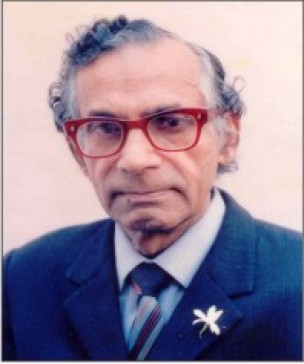A.P. Misra

| Name | A.P. Misra |
| Designation | President |
| Complete postal Address with city code | Indian Phytopathological Society |
| Email IDs | xyz@gmail.com |
| Mobile No. | 123456789 |
Brief Biodata
Professor Ayodhya Prasad Misra was born on the 29th July, 1917 in Faizabad (Uttar Pradesh). He did his B.Sc. from Agra College, Agra, and M.Sc. in Botany during 1941 from Agra College, Agra under Professor K.C. Mehta standing first class first in order of merit. After his post-graduation, Dr. Misra worked for a year at B.R. College, Agra. Thereafter, he joined as Head, Botany Department at A.S.J. College, Lakhaoti. In 1945, he was awarded the Government of India scholarship for higher studies at the University of Minnesota (USA) and worked for his Ph.D. under Dr. E.C. Stakman and Dr. J.J. Christenson, the two world renowned Plant Pathologists. After his return from USA in 1948, he was appointed Assistant Systematic Mycologist in the Directorate of Plant Protection, Quarantine and Storage, Government of India, New Delhi, where he worked with another distinguished Mycologist, the late Dr. B.B. Mundkur. In 1957, he was selected as Professor of Plant Pathology at the Bihar Agriculture College, Sabour, where he continued upto 1968. Later he joined as Principal, Tirhut College of Agriculture and Regional Director, Agriculture Research Institute, Dholi. After creation of Agriculture University in Bihar, he was also Director of Research and Dean, Faculty of Agriculture, R.A.U., Pusa. (Bihar). He superannuated on 29th July, 1975, after 34 years of glorious dedicated service to science. After retirement, he worked as Emeritus Scientist (ICAR) at Tirhut College of Agriculture (RAU), Dholi, where he continued researches on Helminthosporium diseases of wheat, barley and triticales.
Prof. Misra, the doyen among Indian Plant Pathologist, did scintillating work on various aspects of Plant Pathology. His epidemiological work on wheat rust with Prof. K.C. Mehta is frequently referred to in standard text books on Plant Pathology. Dr. Misra’s work of critical environmental conditions vis-à-vis development of epidemics in linseed rust was of paramount importance and found place in J.C. Walker’s text book of “Plant Pathology”.
From 1966-71, he was the Principal Investigator of a U.S. PL-480 research project on “Helminthosporium diseases of cereal crops”. He described 40 species of the genus occurring on 62 graminaceous hosts. Among them, 5 species and one variety were described as new to science. He documented the occurrence of physiological specialization for the first time in several Helminthosporium species. He worked out the role of sexual stage in the development of new strains. Prof. Misra will be remembered for all times to come for his monumental work on helminthosporia. For the significant work done on graminicolous helminthosporia, the USDA awarded him a “Certificate of Appreciation”. He wrote a scientific monograph on “Helminthosporium” which being of classic value, brought him International name and fame.
Prof. Misra also worked on the physiology, pathogenicity, variability and management of important plant pathogens, namely, Alternaria, Colletotrichum, Gloeosporium, Ozonium, Pyricularia and Sclerotium andpublished 160 original research papers in leading National and International journals.
In recognition of his outstanding contributions in the field of Mycology and Plant Pathology, Prof. Misra was elected president of the Indian Phytopathological Society for the year 1978; delivered the Mundkur memorial lecture in 1989, Member of the Executive Council of Mycological Society, Calcutta for 1979; Councilor, International Society of Plant Pathology, 1978-88; Member of Sigma XI; Fellow of the National Academy of Science (FNASc), Fellow of the Indian Phytopathological Society (FPSI), Fellow of the Indian Botanical Society, Councilor Member of Editorial Board of Indian Phytopathological Society, Chief-Editor of Bihar Academy of Agricultural Sciences and member of executive committees, expert committees, board of studies, Agriculture Faculties; Senate, Syndicate, Academic Council and Boards of Management of important institutions, selection committees of UPSC, ASRB and many Universities, etc.
A man of unusual caliber, Prof. Misra contributed lead papers for the Ist International Congress of Plant Pathology (1966); Ist International Microbiological Conference in Bombay (1970); Ist International Mycological Congress held at Exeter (1971); First Internationals Symposium on Endotrophic Mycrorhiza held at Leeds (1974); 2nd International Conference of Plant Pathology held at Minnesota (1973); 3rd International Congress held at Munich (1978); 4th ICPP held at Melbourne (1983); the 5th International Congress held at Kyota (1988) and 3rd International Congress of Plant Pathology held at New Delhi, in 1981. In recognition of his outstanding contributions in Mycology and Plant Pathology, he was assigned a place in the Gallery of Contemporary Noted Mycologists in the International Journal of Mycopathologia et Applicata.
During a span of 37 years of active research,
Prof. Misra inspired and guided 35 M.Sc. and 9 Ph.D. students. Besides being a
distinguished scientist, he was a gifted teacher and able administrator and a
gentleman par excellence. He expired on 22nd July, 1999 at the age
of 82 years at Lucknow.